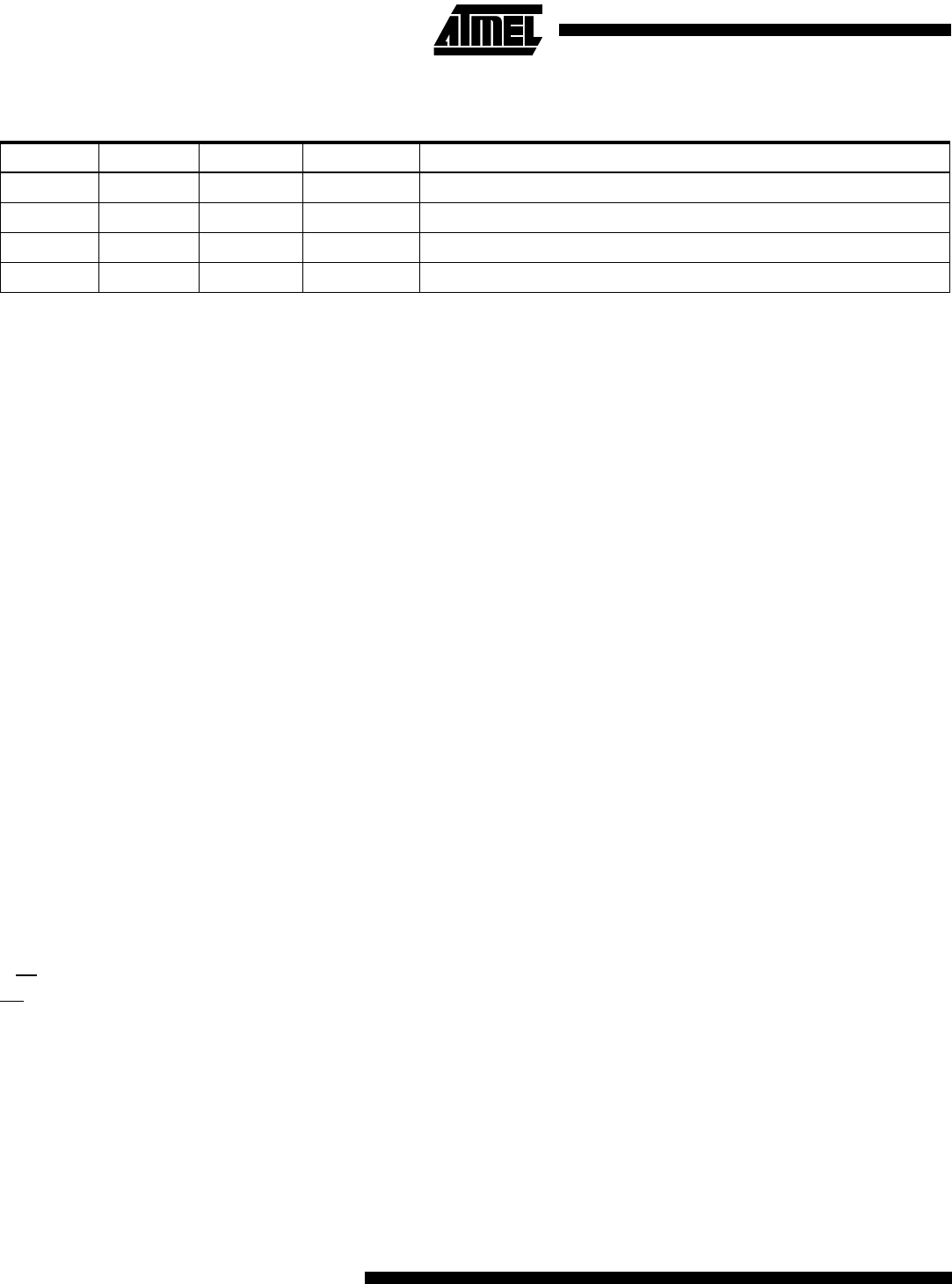Manual
Table Of Contents
- Ordering Information
- Features
- Description
- Architectural Overview
- General Purpose Register File
- ALU - Arithmetic Logic Unit
- ISP Flash Program Memory
- SRAM Data Memory
- Program and Data Addressing Modes
- Register Direct, Single Register Rd
- Register Direct, Two Registers Rd and Rr
- I/O Direct
- Data Direct
- Data Indirect with Displacement
- Data Indirect
- Data Indirect With Pre-Decrement
- Data Indirect With Post-Increment
- Constant Addressing Using the LPM and ELPM Instructions
- Direct Program Address, JMP and CALL
- Indirect Program Addressing, IJMP and ICALL
- Relative Program Addressing, RJMP and RCALL
- EEPROM Data Memory
- Memory Access Times and Instruction Execution Timing
- I/O Memory
- Reset and Interrupt Handling
- Reset Sources
- Power-On Reset
- External Reset
- Watchdog Reset
- MCU Status Register - MCUSR
- Interrupt Handling
- External Interrupt Mask Register - EIMSK
- External Interrupt Flag Register - EIFR
- External Interrupt Control Register - EICR
- Timer/Counter Interrupt Mask Register - TIMSK
- Timer/Counter Interrupt Flag Register - TIFR
- Interrupt Response Time
- Sleep Modes
- Timer/Counters
- Timer/Counter Prescalers
- 8-bit Timer/Counters T/C0 and T/C2
- Timer/Counter0 Control Register - TCCR0
- Timer/Counter2 Control Register - TCCR2
- Timer/Counter0 - TCNT0
- Timer/Counter2 - TCNT2
- Timer/Counter0 Output Compare Register - OCR0
- Timer/Counter2 Output Compare Register - OCR2
- Timer/Counter 0 and 2 in PWM mode
- Asynchronous Status Register - ASSR
- Asynchronous Operation of Timer/Counter0
- 16-bit Timer/Counter1
- Timer/Counter1 Control Register A - TCCR1A
- Timer/Counter1 Control Register B - TCCR1B
- Timer/Counter1 - TCNT1H and TCNT1L
- Timer/Counter1 Output Compare Register - OCR1AH and OCR1AL
- Timer/Counter1 Output Compare Register - OCR1BH and OCR1BL
- Timer/Counter1 Input Capture Register - ICR1H and ICR1L
- Timer/Counter1 in PWM mode
- Watchdog Timer
- EEPROM Read/Write Access
- Serial Peripheral Interface - SPI
- UART
- Analog Comparator
- Analog to Digital Converter
- Interface to external SRAM
- I/O-Ports
- Memory Programming
- Electrical Characteristics
- Typical characteristics
- Register Summary
- Instruction Set Summary (Continued)

ATmega603/103
78
Note: n: 7,6...0, pin number
Alternate Functions of Port B
The alternate pin configuration is as follows:
•
OC2/PWM2, Bit 7
OC2/PWM2, Output Compare output for Timer/Counter2 or PWM output when Timer/Counter2 is in PWM Mode. The pin
has to be configured as an output to serve this function.
•
OC1B/PWM1B, Bit 6
OC1B/PWM1B, Output Compare output B for Timer/Counter1 or PWM output B when Timer/Counter1 is in PWM Mode.
The pin has to be configured as an output to serve this function.
•
OC1A/PWM1A, Bit 5
OC1A/PWM1A, Output Compare output A for Timer/Counter1 or PWM output A when Timer/Counter1 is in PWM Mode.
The pin has to be configured as an output to serve this function.
•
OC0/PWM0, Bit 4
OC0/PWM0, Output Compare output for Timer/Counter0 or PWM output when Timer/Counter0 is in PWM Mode. The pin
has to be configured as an output to serve this function.
•
MISO - Port B, Bit 3
MISO: Master data input, slave data output pin for SPI channel. When the SPI is enabled as a master, this pin is configured
as an input regardless of the setting of DDB3. When the SPI is enabled as a slave, the data direction of this pin is controlled
by DDB3. When the pin is forced to be an input, the pull-up can still be controlled by the PORTB3 bit. See the description of
the SPI port for further details.
•
MOSI - Port B, Bit 2
MOSI: SPI Master data output, slave data input for SPI channel. When the SPI is enabled as a slave, this pin is configured
as an input regardless of the setting of DDB2. When the SPI is enabled as a master, the data direction of this pin is con-
trolled by DDB2. When the pin is forced to be an input, the pull-up can still be controlled by the PORTB2 bit. See the
description of the SPI port for further details.
•
SCK - Port B, Bit 1
SCK: Master clock output, slave clock input pin for SPI channel. When the SPI is enabled as a slave, this pin is configured
as an input regardless of the setting of DDB1. When the SPI is enabled as a master, the data direction of this pin is con-
trolled by DDB1. When the pin is forced to be an input, the pull-up can still be controlled by the PORTB1 bit. See the
description of the SPI port for further details.
•
SS - Port B, Bit 0
SS: Slave port select input. When the SPI is enabled as a slave, this pin is configured as an input regardless of the setting
of DDB0. As a slave, the SPI is activated when this pin is driven low. When the SPI is enabled as a master, the data direc-
tion of this pin is controlled by DDB0. When the pin is forced to be an input, the pull-up can still be controlled by the
PORTB0 bit. See the description of the SPI port for further details.
Table 31. DDBn Effects on Port B Pins
DDBn PORTBn I/O Pull up Comment
0 0 Input No Tri-state (Hi-Z)
0 1 Input Yes PBn will source current if ext. pulled low
1 0 Output No Push-Pull Zero Output
1 1 Output No Push-Pull One Output










